Related Research Articles

Jalāl al-Dīn Muḥammad Rūmī, or simply Rumi, was a 13th-century poet, Hanafi faqih, Islamic scholar, Maturidi theologian and Sufi mystic originally from Greater Khorasan in Greater Iran.
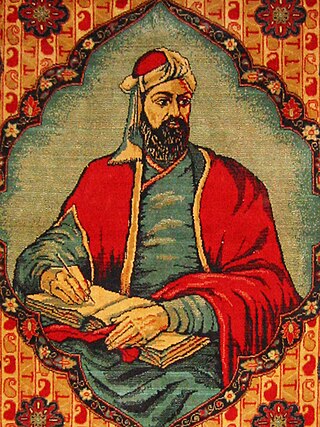
Nizami Ganjavi, Nizami Ganje'i, Nizami, or Nezāmi, whose formal name was Jamal ad-Dīn Abū Muḥammad Ilyās ibn-Yūsuf ibn-Zakkī, was a 12th-century Muslim poet. Nezāmi is considered the greatest romantic epic poet in Persian literature, who brought a colloquial and realistic style to the Persian epic. His heritage is widely appreciated and shared by Afghanistan, Republic of Azerbaijan, Iran, the Kurdistan region and Tajikistan.

Persian literature comprises oral compositions and written texts in the Persian language and is one of the world's oldest literatures. It spans over two-and-a-half millennia. Its sources have been within Greater Iran including present-day Iran, Iraq, Afghanistan, the Caucasus, and Turkey, regions of Central Asia, South Asia and the Balkans where the Persian language has historically been either the native or official language. For example, Rumi, one of the best-loved Persian poets, born in Balkh or Wakhsh, wrote in Persian and lived in Konya, at that time the capital of the Seljuks in Anatolia. The Ghaznavids conquered large territories in Central and South Asia and adopted Persian as their court language. There is thus Persian literature from Iran, Mesopotamia, Azerbaijan, the wider Caucasus, Turkey, Pakistan, Bangladesh, India, Tajikistan and other parts of Central Asia, as well as the Balkans. Not all Persian literature is written in Persian, as some consider works written by ethnic Persians or Iranians in other languages, such as Greek and Arabic, to be included. At the same time, not all literature written in Persian is written by ethnic Persians or Iranians, as Turkic, Caucasian, Indic and Slavic poets and writers have also used the Persian language in the environment of Persianate cultures.

The Reformists are a political faction in Iran. Iran's "reform era" is sometimes said to have lasted from 1997 to 2005—the length of President Mohammad Khatami's two terms in office. The Council for Coordinating the Reforms Front is the main umbrella organization and coalition within the movement; however, there are reformist groups not aligned with the council, such as the Reformists Front.

Sohrab Sepehri was a notable Iranian poet and painter. He is considered to be one of the five most famous Iranian poets who have practiced modern poetry alongside Nima Youshij, Ahmad Shamlou, Mehdi Akhavan-Sales, and Forough Farrokhzad. Sepehri's poems have been translated into several languages, including English, French, Spanish, Italian, Lithuanian and Kurdish.

Ahmad Shamlou was an Iranian poet, writer, and journalist. Shamlou was arguably the most influential poet of modern Iran. His initial poetry was influenced by and in the tradition of Nima Youshij. In fact, Abdolali Dastgheib, Iranian literary critic, argues that Shamlou is one of the pioneers of modern Persian poetry and has had the greatest influence, after Nima, on Iranian poets of his era. Shamlou's poetry is complex, yet his imagery, which contributes significantly to the intensity of his poems, is accessible. As the base, he uses the traditional imagery familiar to his Iranian audience through the works of Persian masters like Hafez and Omar Khayyám. For infrastructure and impact, he uses a kind of everyday imagery in which personified oxymoronic elements are spiked with an unreal combination of the abstract and the concrete thus far unprecedented in Persian poetry, which distressed some of the admirers of more traditional poetry.

Ardashir I, also known as Ardashir the Unifier, was the founder of the Persian Sasanian Empire. He was also Ardashir V of the Kings of Persis, until he founded the new empire. After defeating the last Parthian shahanshah Artabanus IV on the Hormozdgan plain in 224, he overthrew the Parthian dynasty and established the Sasanian dynasty. Afterwards, Ardashir called himself "shahanshah" and began conquering the land that he called Iran.
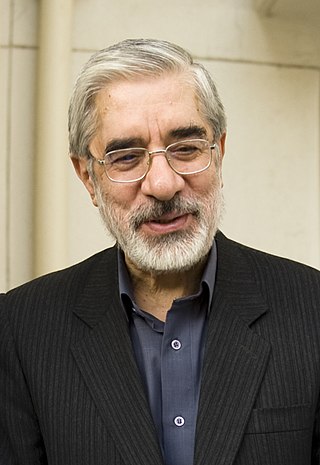
Mir-Hossein Mousavi Khameneh is an Iranian reformist politician, artist and architect who served as the 49th and last Prime Minister of Iran from 1981 to 1989. He was a reformist candidate for the 2009 presidential election and eventually the leader of the opposition in the post-election unrest. Mousavi served as the president of the Iranian Academy of Arts until 2009, when conservative authorities removed him. Although Mousavi had always considered himself a reformist and believed in promoting change within the 1979 Revolution constitution, on 3 Feb 2023, in response to the violent suppression of Iranians by Ali Khamenei, the Supreme Leader of Iran, he announced opposition to the Islamic Republic constitution and asked for a widespread referendum to fully change the constitution and make a fundamental change in Iran's political system.
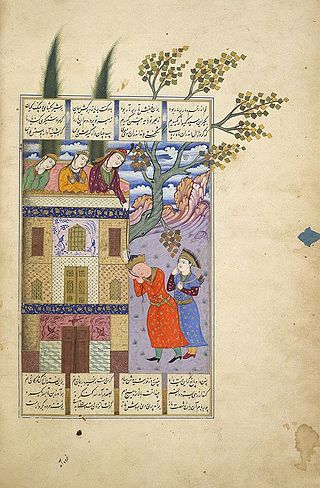
Zāl, alternatively spelled as Zaal, is a legendary Iranian king from Sistan, and is recognized as one of the greatest warriors of the Shahnameh epic. He is the father of the equally legendary Iranian hero, Rostam.
Zeyn al-Abedin Maraghei was a pioneer Iranian novelist and a social reformer. He is most known for the 1895 story of Travel Diary of Ebrahim Beg. This work was critical in the development of novel writing in twentieth-century Iran, and played an important political role as well. The story was a criticism on Iran's political and social affairs. It was widely read in Iran and gained the interest of revolutionaries and reformers who made the Constitutional Revolution of 1906.

Prince Iraj Mirza, son of prince Gholam-Hossein Mirza, was a famous Iranian poet. He was a modern poet and his works are associated with the criticism of traditions. He also made translation of literary works from French into Persian.

Zahhāk or Zahāk, also known as Zahhak the Snake Shoulder, is an evil figure in Persian mythology, evident in ancient Persian folklore as Azhi Dahāka, the name by which he also appears in the texts of the Avesta. In Middle Persian he is called Dahāg or Bēvar Asp the latter meaning "he who has 10,000 horses". In Zoroastrianism, Zahhak is considered the son of Ahriman, the foe of Ahura Mazda. In the Shāhnāmah of Ferdowsi, Zahhāk is the son of a ruler named Merdās.
Vis and Rāmin is a classical Persian love story. The epic was composed in poetry by Fakhruddin As'ad Gurgani in the 11th century. Gorgani claimed a Sasanian origin for the story, but it is now regarded as of Parthian dynastic origin, probably from the 1st century AD. It has also been suggested that Gorgani's story reflects the traditions and customs of the period immediately before he himself lived. That cannot be ruled out, as stories retold from ancient sources often include elements drawn from the time of their narrator.
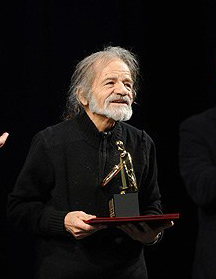
Jalaal Zulfonun was an Iranian musician, setaar player, and a prominent composer and teacher of Persian music.
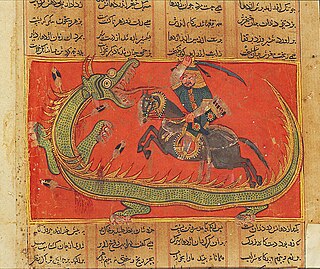
Garshāsp was, in Persian mythology, the last Shah of the Pishdadian dynasty of Persia according to Shahnameh. He was a descendant of Zaav, ruling over the Persian Empire for about nine years. His name is shared with a monster-slaying hero in Iranian mythology. The Avestan form of his name is Kərəsāspa and in Middle Persian his name is Kirsāsp.
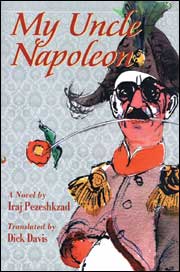
My Uncle Napoleon is a coming of age novel by Iranian author Iraj Pezeshkzad published in Tehran in Persian in 1973. The novel was adapted as a TV series in 1976, directed by Nasser Taghvai. Though the book and the TV series were briefly banned following the Islamic Revolution of 1979 in Iran, it remained popular. It is noted for its lampooning of the common social attitudes and beliefs in Iran during the period of Allied occupation of Iran. The novel has been translated by Dick Davis into English.

Saadi Shīrāzī, better known by his pen name Saadi, also known as Sadi of Shiraz, was a Persian poet and prose writer of the medieval period. He is recognized for the quality of his writings and for the depth of his social and moral thoughts.

Farhad Aslani is an Iranian actor.

Mohammad Reza Pahlavi, commonly referred to in the Western world as Mohammad Reza Shah, was the last Iranian monarch. He began ruling the Imperial State of Iran after succeeding his father Reza Shah in 1941 and remained in power until he was overthrown by the Iranian Revolution, which abolished the country's monarchy and established the present-day Islamic Republic of Iran in 1979. Owing to his recognition and status as Iran's final monarch, he is usually called the Shah. In 1967, he took up the title Shahanshah and held several others, including Aryamehr and Bozorg Arteshtaran.
Babak and Friends - A First Norooz is a direct-to-DVD animated film by Norooz Productions, later renamed Big Bad Boo Studios. The 33-minute animated cartoon was released in 2005. The film was made to teach children about the Persian New Year Norooz, celebrating the coming of spring and is about a little boy named Babak who is stuck between being Iranian and being American. Through a dream and magical visit by Amoo norooz, Babak learns to be proud of his heritage and celebrates the New Year with his family.